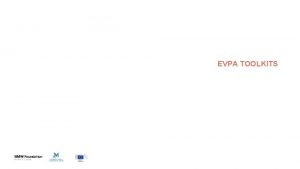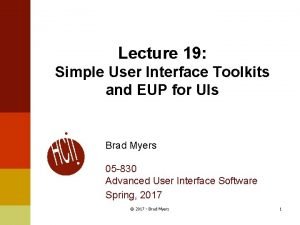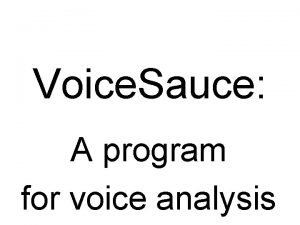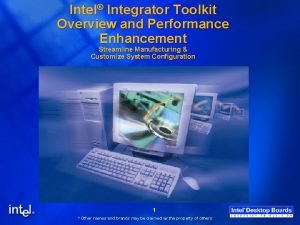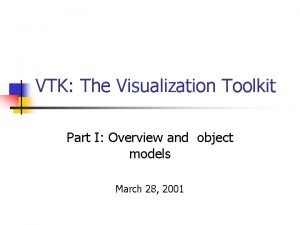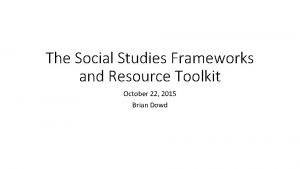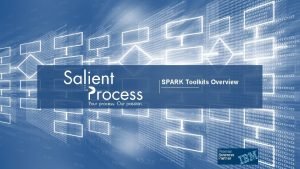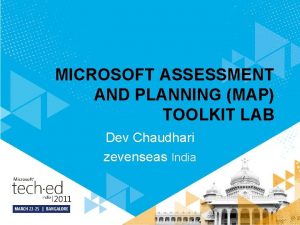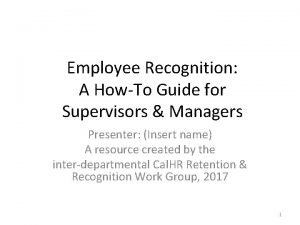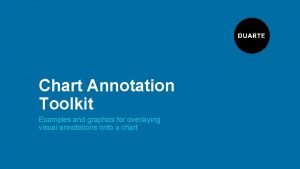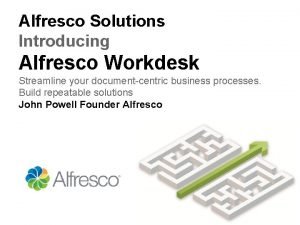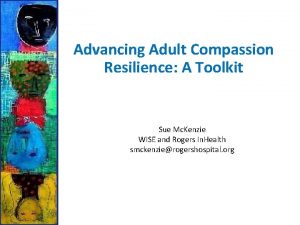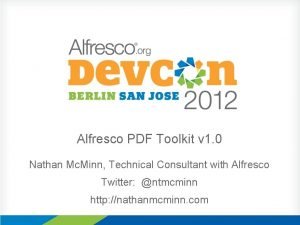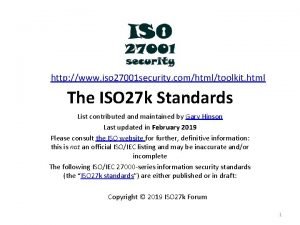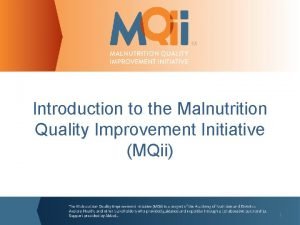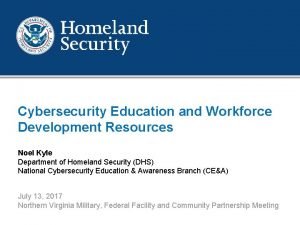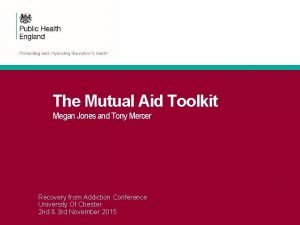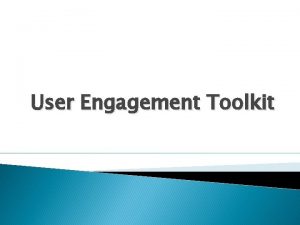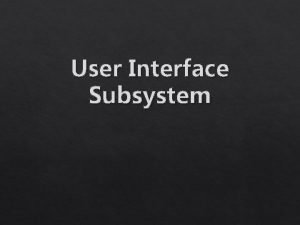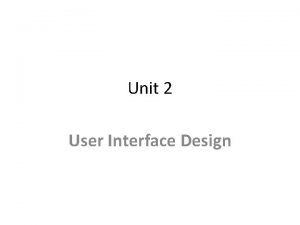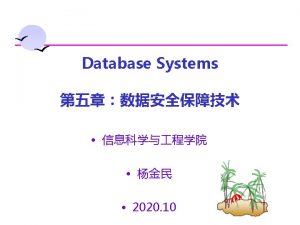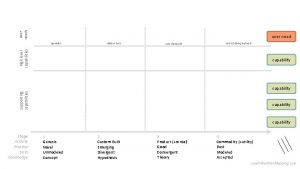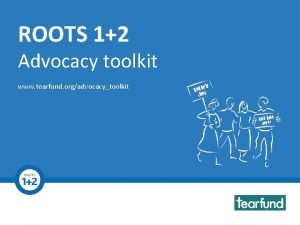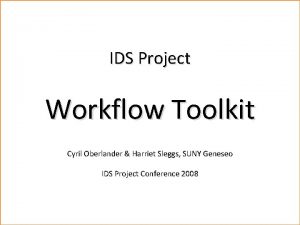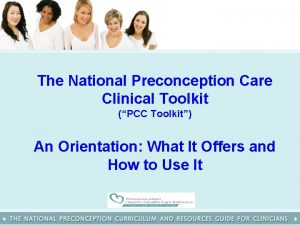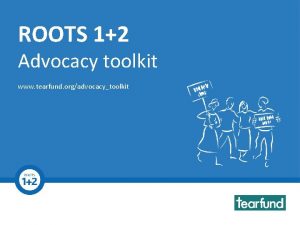User Engagement Toolkit User Engagement Toolkit 1 2
































- Slides: 32

User Engagement Toolkit

User Engagement Toolkit 1. 2. 3. 4. 5. 6. 7. 8. 9. Irish Legislation Health and Safety Insurance Garda Clearance Responsibilities Design Project Protocol Risks and Benefits User Engagement Plan Data Management Plan 10. 11. 12. 13. 14. 15. 16. 17. 18. Ethics Protocol Ethical Approval Reimbursement or Payment Understanding the Specific Needs of Your Users Confidentiality and Privacy Participant Information Informed Consent Use of Data Following up with the User

Which sections where? � Before design � (1), (2), (3), (4), (6), (7), (8), (9), (10), (11), (13), (14), (15), (16), (17) � During design � (1), (5), (7), (8), (9), (11), (13), (14), (16), (17) � After design � (5), (7), (9), (12), (14), (17), (18)

Group 1 � Mary O’Donohue � Dougie Izett � Alan Flood � Carl O’Brien � Gary Thompson

Group 2 � Gary Cooke � Philip O’Donnell � Adam Szigeti � Aileen Leacy � Christian Ajayi � Peter Prunty

Group 3 � Sharon Webb � Fergal Brady � Emma Curran � David Hogan

Group 4 � Andreea Tanasa � Oisin Kelly

General Comments � Create a glossary of terms � Show a hierarchy between participants � Have an executive summary with intended audience, etc.

Ethical Approval, Reimbursement of Payment, Informed Consent, Confidentiality and Privacy, Participant Information. Group 1

Overall � “Who” section could be converted into RACI matrix for whole document, explaining roles for all of the sections � Are Actor descriptions appropriate? Nonstandard terms. � Everything written in terms of academic institution performing study in medical research arena – not allowing for any other scenarios.

Overall � Summary Checklists seem to be well written. The Details have too much waffle. Details moved to after Summary Checklists. � Could be split into principles and practise – could be better organised with Background etc. � References not cited. � No section numbers.

Ethical Approval � Large assumptions made that there will be a Research Ethics Committee available who will be able to provide everything. No direction given for the case where no such committee exists. � The “Student” is wholly dependent on the direction given by the Principal Investigator and Lecturer on ethical approval.

Reimbursement of Payment � Self-contradicting: reimbursing and coercion versus “not out-of-pocket” � Suggests that person with learning difficulty send emails instead of written consent.

Informed Consent � Student seeking informed consent should be overseen by the Lecturer and Principle Investigator. � Specific guidelines should be referred to which define sufficient participant information, perhaps published by the institution. � The type of event that would require renewal of informed consent should be defined. � The user should be consulted on their specific needs , or the users guardian should be consulted in order to define how the “comfort, wellbeing and dignity” of the user can be ensured. The user's needs should be communicated to all parties involved in the project prior to the commencement of any activity.

Confidentiality and Privacy � Page and section numbers � Split “Details” into Principles and Practice � Review Data Protection advice- not sure it is correct/ goes far enough. What does “secure manner” actually mean? � Put participant information and informed consent into “” to set aside from std text. � Check punctuation � References not clear to which parts these are relevant.

Participant Information � The sentence structure is too long � Is a Participant a user? – if so settle on one term � Lack of glossary � Separate the what from the how – identify what needs to be done from how or why it needs to be achieved

Ethics Protocol, Data Management Plan, Risks and Benefits, User Engagement Plan. Group 2

Who? • • • Needs a hierarchy in the definition Principal investigator and Lecturer do not have sufficiently different defined roles Similarly, Student and User appear to have similar roles

Who? • Redefine with hierarchy: • Institution: Preparing the code of practice • Lecturer: Prepare ethics protocol in line with the institution’s code of practice. Advise students on how to follow the protocol. • Student: Follow ethics protocol and provide feedback on the protocol to the lecturer.

General comments � Who is the document aimed at? � There should be a statement of assumptions and definitions e. g. What is a risk? What is a benefit? � Ethics protocol details section description of risk and mitigation too complicated. � Type of project will determine risk and benefits e. g. Investigative project to discover outcomes.

General comments � Create a protocol template. Need guidelines on how this is done � Define what will be done to/by the user, and how the results will be used. � References at the end of the document, but no citing in the main body of text.

Legislation Health and Safety Insurance Garda Clearance Group 3

General Critical Review � The description of the users is repeated throughout every section as is their roles even when they remain the same as the preceding sections. The document would benefit from a hierarchical map or table of the users, and their responsibilities.

General Critical Review � Legislation is often highlighted with no explanation of its provisions, similarly repeated references occur, while no appendix or bibliography is apparent. � The four sections overall appear quite “wordy” and appear to have been generated as standalone sections with no attempt to concatenate them.

Legislation � The legislation highlighted that the following people are involved, the principal, the lecturer, the student, the user and the institution. Their roles differ, the principal, the lecturer and the institution are required to understand their responsibilities and provide advice. The students and users role is just to understand adhere to it. It identifies the difference between private and public institutions and the legalisations degree of applicability to each. It outlines several types of legalisation. These cover the requirements in engagement ranging from ethical approval, informing users, obtaining consent, retaining and destroying data, confidentiality, storage, provision of access, adherence to legislation and discrimination.

Health and Safety � It outlines the five different parties, the principal, the lecturer, the student, the user and the institution. Health and safety is concerned with the engagement of activates. The role of the principal and the lecturer is to identify health and safety issues and inform the students. The student’s role is to adhere to the codes of practice. The user should highlight any requirements they have for health and safety e. g. if the user has a wheel chair and requires mobility access, the institutions role is to provide guidance to staff and students. The nature of the interaction is important e. g. tasks that could affect physical and mental wellbeing should be considered in regards of health and safety.

Insurance � Insurance needs to be in place for all parties involved in any type of engagement. The roles involved include the principal, the lecturer, the student, the user and the institution. Students and users should raise questions and make sure that insurance is in place. The principal and the lecturer need to discuss with the institution what kind of insurance is in place and if anything further is required. The institution and the principal are responsible for ensuring that any insurance and indemnity are in place before any engagement takes place. It needs to cover both the institution and any sponsor even if the sponsor is outside of the institution. There may be potential issues with regard to the nature of the project and these should be reviewed with regard to health and safety.

Garda Clearance � The section on Garda Clearance refers to the requirement of all agents involved in user engagement with potentially vulnerable user groups to seek clearance from the National Vetting Bureau in advance. The principal and lecturer should identify if students and staff require clearance well in advance of user engagement. The student should ask if they require Garda Clearance, while the user should consult with their organisation if they have concerns about engaging with designers or design students and discuss these with the with Garda. The institution must advise staff and students. There are details in this section which discuss the change in legislation.

Following up with the User Use of Data Group 4

Following up with the User • No Difference between the role of the Principal Investigator and Lecturer. • Unclear on what students role is “If user feedback is students responsibility” • The User section puts the onus on the user to find out how their data is being used.

Following up with the User • Good that policy allows follow after the user input • Nice that Users can be called out for recognition. • User engagement form is mentioned but it could be created so that there is temple sent with the project. • A hierarchy of who is in charge and summary of terms would also be useful

Use of Data � No difference between the Principal Investigator and Lecturer � The Details part doesn’t offer me any extra information than the Summary Checklist, so it can be replaced with the second one and get rid of the hard language used, that, in my opinion, it is not useful.
 Employee engagement toolkit
Employee engagement toolkit Employee engagement action planning toolkit
Employee engagement action planning toolkit User interface toolkit
User interface toolkit Single user and multiple user operating system
Single user and multiple user operating system Rtos multitasking
Rtos multitasking Praat vocal toolkit
Praat vocal toolkit Toolkit 6 better investing
Toolkit 6 better investing Texas equity toolkit
Texas equity toolkit Weka machine learning toolkit
Weka machine learning toolkit Menucrm
Menucrm Intel itk
Intel itk Fso toolkit
Fso toolkit Renderer
Renderer Social studies toolkit
Social studies toolkit Spark ui toolkit
Spark ui toolkit Microsoft assessment and planning
Microsoft assessment and planning Martin urschler
Martin urschler Employee recognition toolkit
Employee recognition toolkit Annotation toolkit
Annotation toolkit Noaa weather climate toolkit
Noaa weather climate toolkit Alfresco pdf toolkit
Alfresco pdf toolkit Indiana social emotional learning
Indiana social emotional learning Compassion resilience toolkit
Compassion resilience toolkit Alfresco pdf toolkit
Alfresco pdf toolkit Psnc dsp toolkit
Psnc dsp toolkit Sales enablement toolkit
Sales enablement toolkit Iso 27550
Iso 27550 Mqii
Mqii Weather climate toolkit
Weather climate toolkit Noel kyle
Noel kyle Activepdf toolkit
Activepdf toolkit Mutual aid toolkit
Mutual aid toolkit Genexus web extension toolkit
Genexus web extension toolkit
